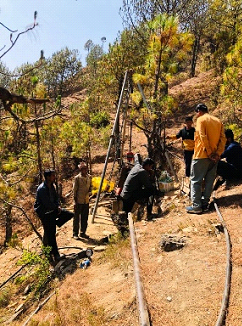


| Client: | Department of Electricity Development |
| Funding Agency: | Government of Nepal |
| Period: | March 2020 to September 2022 |
| Consulting Association: | Joint Venture of Energy Infratech Pvt Ltd, India and GEOCE Consultants (P) Ltd, Nepal in association with Technoquarry Consults (P) Ltd and BEAM Consultants (P) Ltd |
| Approx. Value of Services: | Total NRs 140 million, GEOCE’s part NRs 79.13 million |
| Professional Staff Input: | International – 23 person months, National – 144.5 million |
Salient Details
The consulting service is to conduct feasibility study, detailed engineering design and EIA study of the project (362 MW) and prepare study report covering technical, financial, socio-economic, institutional, environmental and any other relevant aspects of project development. The project lies at the most upstream of Khimti -I HEP (60 MW) and Khimti- II HEP (48 MW). It will construct about 210 m high dam with live storage of 633 Mm3.
The scope of services is carried out in following components:
⦁ Feasibility study
⦁ EIA study including social safeguard related studies
Feasibility Study
⦁ Data collection and review.
⦁ Desk study and field reconnaissance survey, analyze available data and identify data gap of previous study.
⦁ Carry out preliminary project layout and configuration (at least 3) based examine alternatives of project component.
⦁ Conduct engineering survey and field investigation (topographical surveys, hydrological studies, sediment studies and hydro-metrological surveys; geological surveys, engineering geological mapping, geophysical and geotechnical investigations including core drilling (about 1,280 m), in-situ tests, seismic study, construction materials surveys and testing, alignment survey of transmission line, communication surveys for transportation of equipment, construction power survey, power evacuation survey, feasibility survey of access and project road.
⦁ Survey and design of re-regulating dam.
⦁ Analysis of field surveys and investigation tests.
⦁ Prepare and establish design criteria for the design of all major components and associated structures.
⦁ Prepare preliminary layout and design considering alternative configuration of project component and conduct optimization of the components and associated structures of hydropower project for the best option and optimum use of resources.
⦁ Develop and numerical model for the river stretches for use as a tool for optimizing the project layout, flow regulation, installation. and mode of operation.
⦁ Conduct optimization study, cost estimates and economic/financial analysis of the project at all the possible options of project layout and flow regulation from dam. Optimization of project is based on consideration of dam location, powerhouse location, flow regulation, storage capacity, peaking scenario, downstream effects etc. Analysis was done with these parameters by considering the financial and economic benefits and recommend the best option.
⦁ Assess power and energy, rehabilitation and resettlement cost and benefits from the project.
⦁ Conduct power evacuation study to the Integrated Nepal Power System.
⦁ Carry out project layout and design. Conduct hydraulic and structural design of civil structures such as dam, intake, water ways (diversion tunnel, power tunnel, surge tank, drop shaft), powerhouse with tail race and switchyard.
⦁ Conduct planning and design of switchyard, transmission line (220 kV, length about 20 km.
⦁ Design of hydraulic steel structures such as gates, valves, and penstock pipes.
⦁ Conduct feasibility study of the access road, project road, bridges, and cross-drainage structures.
⦁ Planning of camp site and offices and their required facilities.
⦁ Prepare construction plan and schedules for project implementation.
⦁ Prepare cost estimates including cash flows in local and foreign currencies.
⦁ Conduct economic and financial analysis of the project including sensitivity analysis including cost allocation and cost sharing among project components.
⦁ Prepare Rehabilitation and Resettlement plan and associated costs.
Environmental Impact Assessment (EIA) Study (as per EPA, 1997 and EPR, 1998)
⦁ Preparation of scoping document and terms of reference
⦁ Conduct EIA study (baseline study of existing environmental parameters -physical, biological, socio-economic, and cultural- in impact zones)
⦁ Land inventory and property acquisition survey
⦁ Identify, examine, and assess project implementation activities of hydropower project, transmission line and substation, access and project road, camp site and office complex, quarry site etc.
⦁ Identify and predict key physical, biological, socio-economic, and cultural positive and negative impacts and issues associated with project implementation.
⦁ Identify project affected persons, identify potential areas for resettlement requirements of the displaced families.
⦁ Propose mitigation measures to avoid or minimize potential adverse environmental impacts and suggest enhancement measures to enhance the beneficial impacts.
⦁ Prepare an environmental management plan to implement the proposed mitigation measures
⦁ Prepare environmental monitoring plans
⦁ Prepare EIA report





